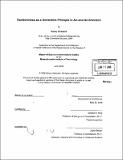Randomness as a generative principle in art and architecture
Author(s)
Verbeeck, Kenny
DownloadFull printable version (17.62Mb)
Other Contributors
Massachusetts Institute of Technology. Dept. of Architecture.
Advisor
George N. Stiny.
Terms of use
Metadata
Show full item recordAbstract
As designers have become more eloquent in the exploitation of the powerful yet generic calculating capabilities of the computer, contemporary architectural practice seems to have set its mind on creating a logic machine that designs from predetermined constraints. Generating form from mathematical formulae thus gives the design process a scientific twist that allows the design to present itself as the outcome to a rigorous and objective process. So far, several designer-computer relations have been explored. The common designer-computer models are often described as either pre-rational or post-rational. Yet another approach would be the irrational. The hypothesis is that the early design process is in need of the unexpected, rather than iron logic. This research investigated how the use of randomness as a generative principle could present the designer with a creative design environment. The analysis and reading of randomness in art and architecture production takes as examples works of art where the artist/designer saw uncertainty or unpredictability as an intricate part of the process. The selected works incorporate, mostly, an instigating and an interpreting party embedded in the making of the work. (cont.) The negotiations of boundaries between both parties determine the development of the work. Crucial to the selected works of art was the rendering of control or choice from one party to another - whether human, machine or nature - being used as a generative principle. Jackson Pollock serves as the analog example of a scattered computation: an indefinite number of calculations, of which each has a degree of randomness, that relate in a rhizomic manner. Pollock responds to each of these outcomes, allowing the painting to form from intentions rather than expectations. This looking and acting aspect to Pollock's approach is illustrated in the Jackson Pollock shape grammar. Ultimately the investigation of randomness in art is translated to architecture by comparing the Pollock approach in his drip paintings to Greg Lynn's digital design process in the Port Authority Gateway project. In the Pollock approach to digital design agency is given to the tools at hand, yet at the same time, the sheer indefinite number of designer-system interactions allows the design to emerge out of that constructive dialogue in an intuitive manner.
Description
Thesis (S.M.)--Massachusetts Institute of Technology, Dept. of Architecture, 2006. Includes bibliographical references (leaves [87]-[98]).
Date issued
2006Department
Massachusetts Institute of Technology. Department of ArchitecturePublisher
Massachusetts Institute of Technology
Keywords
Architecture.